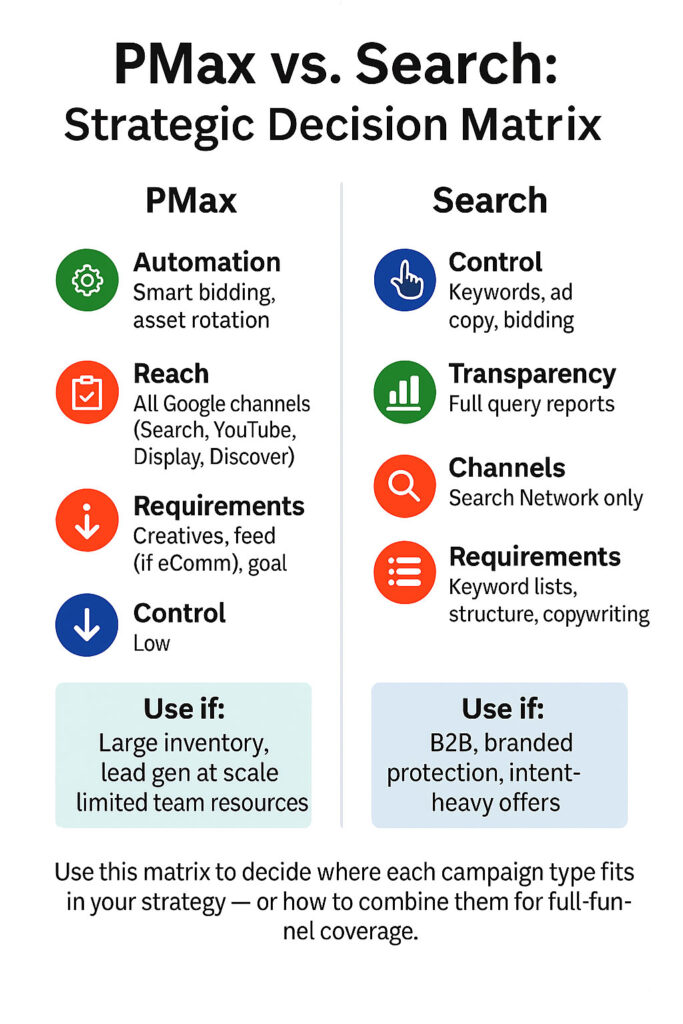
Performance Max (PMax) and traditional Search campaigns serve distinct purposes in Google Ads. One prioritizes automation and reach across Google’s ecosystem; the other provides granular, intent-based control. Understanding when and how to use each is critical to a modern paid media strategy.
What Performance Max Actually Does
PMax campaigns distribute ads across Google’s full inventory — Search, Display, YouTube, Discover, Gmail, and Maps — from a single setup. Advertisers provide:
- Creative assets (images, headlines, videos, descriptions)
- Optional audience signals
- Product or service feed (for eCommerce)
Google’s system then determines:
- Ad placements
- Creative combinations
- Bidding strategy
- Targeting (based on signals and intent)
Key Traits:
- No keyword or placement controls
- Automated creative and bidding
- Multi-surface delivery
What Search Campaigns Still Own
Search campaigns are built around explicit keyword targeting. Advertisers choose what queries to show for, craft specific ads, and control bidding rules.
Strengths:
- Full control over keywords and match types
- Transparent search term reporting
- Intent-focused targeting
- Ideal for high-precision verticals: B2B, services, brand defense
Side-by-Side Comparison
| Attribute | Performance Max | Search Campaigns |
|---|---|---|
| Setup | Asset-based, fast setup | Manual keywords + structure |
| Reach | All Google networks | Search Network only |
| Control | Low | High |
| Creative | Auto-generated from assets | Fully custom per ad group |
| Targeting | Signal-based | Keyword-driven |
| Reporting | Aggregated by asset group | Query and placement-level |
| Best for | eCommerce, lead gen, discovery | Branded, high-ROI, B2B |
Common Misconception: PMax = Smarter Search
Performance Max is not a replacement for Search. It’s a distinct campaign type designed to find conversions across surfaces — not to respond to specific user queries. If you replace branded Search with PMax, expect higher CPAs and less clarity.
Example:
A B2B SaaS firm tested PMax for form-fills. CPA rose sharply due to lack of query control. They reverted to exact match Search campaigns paired with CRM scoring — restoring quality and lowering cost.
Hybrid Models: Best of Both Worlds
1. Intent + Discovery
- Use Search for proven keywords
- Layer PMax to explore new demand
- Exclude brand from PMax to avoid cannibalization
2. Catalogs + Strategy
- Run PMax with product feed for broad coverage
- Use Search for high-margin, seasonal, or promo items
3. Local Services
- Search for intent-rich queries (“clinic near me”)
- PMax for remarketing, YouTube, Maps visibility
Keeping PMax in Check
To avoid waste, implement governance:
- Provide strong audience signals (site visitors, CRM lists)
- Use conversion value rules
- Exclude weak geo-locations and app placements
- Separate campaigns by product or service category
Measurement: What Changes
With PMax, some visibility is lost:
- No query-level reporting
- Limited control over placements or device splits
But you gain:
- Broad reach and channel coverage
- Auto-tested asset combinations
- Summary-level performance by audience or creative
Control Tips:
- Segment asset groups clearly
- Track with GA4 + UTMs
- Import offline conversions (CRM/sales)
Strategic Matrix: When to Use What
| Scenario | Recommended Type |
|---|---|
| Branded traffic | Search (Exact Match) |
| Product catalog promotion | PMax with Merchant Feed |
| Lead capture via forms | Search + PMax Blend |
| Discovering new audiences | Performance Max |
| Precise control over bidding | Search Campaigns |
Final Takeaway
Search campaigns remain unmatched in transparency and control. PMax delivers scalability and automation across Google’s full ecosystem. The best strategies blend both — anchoring on intent, scaling with automation.
You don’t choose between them. You architect the system.
Work with 3MY: Build the Right Campaign Architecture from Day One
At 3MY, we don’t just run ads — we build Google Ads systems tailored to your business model, customer journey, and growth goals.
We specialize in:
- eCommerce brands with product catalogs
- B2B companies with CRM-integrated funnels
- Local businesses using form or call tracking
- DTC and service providers across verticals
Every engagement includes:
- Strategic separation of PMax and Search
- Feed integration and audience rules
- Custom conversion tracking
- Ongoing optimization + detailed reporting
[Book a Free Google Ads Audit →]










